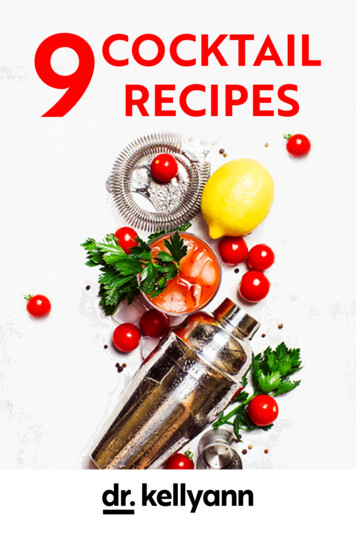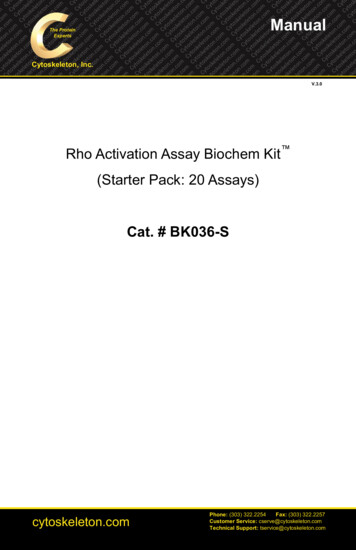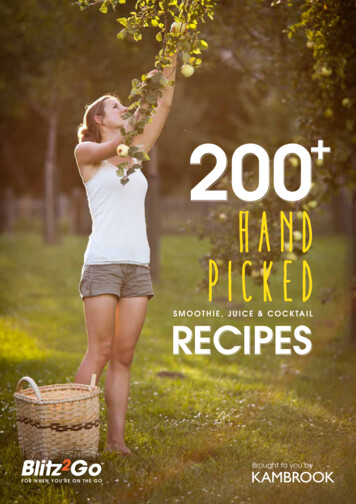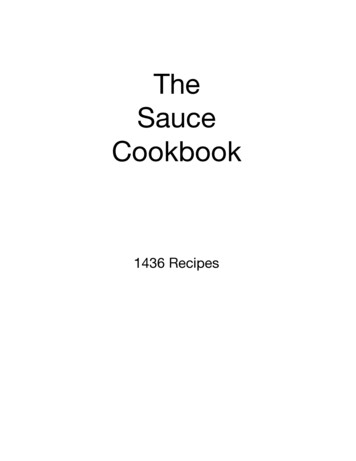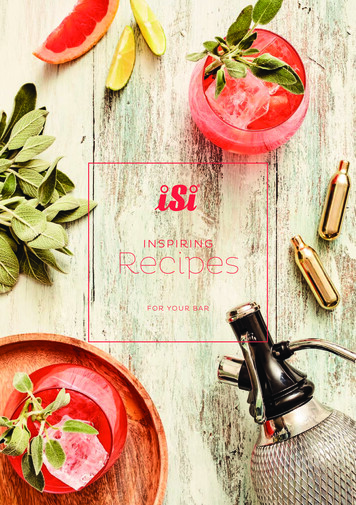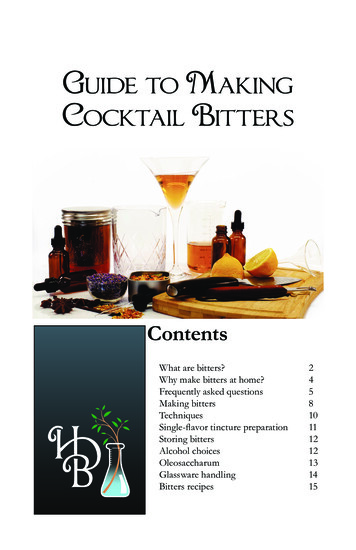
Transcription
Guide to MakingCocktail BittersContentsBWhat are bitters?2Why make bitters at home?4Frequently asked questions5Making bitters 8Techniques 10Single-flavor tincture preparation11Storing bitters 12Alcohol choices 12Oleosaccharum 13Glassware handling 14Bitters recipes15
What are bitters?Bitters began as medicinal tinctures. Angostura, the most famous bitters of all, was developed as a cure for seasickness and other stomachcomplaints. The herbs and spices that create the bitter flavors have beenused in herbal medicine for hundreds of years. By adding aromatic herbsand sweetener, we can balance the bitter taste and make it pleasant to drink.Bartenders discovered that bitters can mellow the harshness of alcohol andadd pleasant flavors, and thus the cocktail was born.2
3
Why make bitters at home?Because store-bought bitters are boring. Homemade bitters offer an endless array of flavors limited only by your imagination and access to ingredients. It’s also fun.The basic process isn’t complex at all: concentrated flavor extracts arecreated by soaking or steeping various herbs and spices in water or highproof neutral alcohol, such as vodka. Blend the concentrates together indifferent ratios to create unique taste profiles. Think of it as cooking withan entirely different palette of flavors. Some basic recipes and some simpleequipment and ingredients are all you need to get started. From there you’refree to experiment and go where your tastes and available ingredients takeyou.4
Frequently asked questionsDoes it matter what kind of alcohol I use to make my bitters?The reason we recommend using neutral flavored spirits such as vodkais that the flavor of other types of alcohol can be overwhelming. If you wantto include flavors from spirits like rye whiskey or brandy, use equal partsvodka and the other spirit so that the flavors of the spices get a chance toshine.Can I make the bitters with water so they are non-alcoholic?The reasons we recommend using some form of alcohol for making bitters are two-fold: polarity and resistance to spoilage.You’ve heard that oil and water don’t mix right? That’s due to polarity,a physical property of the water and oil molecules. On the spectrum fromwater to oil, ethanol falls near the middle and therefore can dissolve bothoil and water-based flavors out of the spices and herbs. High-proof spirits(100 proof/50% ABV or more) have more ethanol and less water, pushingthem closer to the middle of the polarity spectrum, making them betterat dissolving the oil-based flavors like cinnamon and citrus. You can usewater to make bitters but it will dissolve less of the flavorful essentialoils out of the spices for a weak or unbalanced flavor.The second reason for using alcohol is that it is anti-bacterial and anti-fungal, so your alcohol-based bitters won’t turn slimy, stringy, or haveweird green lumps on top, no matter how long they sit on the shelf. Water-based bitters must be refrigerated and used quickly, or frozen, to keepbacteria and mold from taking over.Adding a dash of 80-proof bitters to an 8-ounce glass of sparkling waterresults in an ethanol concentration of about 0.0065% ABV, less than the average for soft drinks (0.04 – 0.08%) or yeast-raised breads such as sourdough(0.31 – 0.45%) and pizza crust (0.09 – 0.42%).5
How do I use bitters? They’re only for drinks, right?Think of bitters as a liquid spice cabinet. You can add them to any dishwhere that flavor might be appealing. Add a few dashes to soup or saladdressing. Substitute bitters for all or part of the vanilla extract in a cookierecipe. Drizzle a little over ice cream. Not every flavor will work in everydish, but if you’re worried about overwhelming your food, scoop out a sample and add a drop of bitters at a time to see if you like the combination.For cocktails, try to find complementary flavors. Instead of combiningingredients of the same flavor, like orange juice with orange bitters, try acontrasting flavor like hibiscus. Smoky barbecue bitters work well with thesweet and sour flavor of pineapple juice and lemon bitters are delicious withpiney gin. Bitters are more about adding depth and complexity to a drink,not just reinforcing the main components.Bitters also contain herbs that have been used for medicinal purposesfor centuries. Please research the individual herbs or ask an herbalist if youhave specific health concerns. While we do not claim any specific medicinalbenefits of using bitters, some people find bitters and soda soothing forindigestion and heartburn, for example.Why does it take so long to make bitters?The two reasons bitters benefit from a long soak are related to surfacearea and the chemicals that dissolve out of the spices to flavor the bitters.Whole spices take longer to infuse because the cell walls of the planttissues make it difficult for the flavor molecules to escape. Crushing orgrinding the spices can help the flavors infuse faster but then they are moredifficult to filter out later. As the flavor chemicals are floating around in theethanol, they may continue to interact with other chemicals to form newflavors that weren’t present in the individual spices.6
What is the best flavor? Which one will I like?Just as we all have different opinions about the flavor of foods, the bestflavor of bitters will depend on what flavors the drinker likes and what otheringredients are in the glass. Some people love the flavor of licorice while others don’t even like the smell. Smell and taste are strongly tied to memories,which is probably why so many foods are an “acquired taste,” because theyare associated with pleasant memories of family meals in childhood.When deciding which bitters recipes to try, look at the ingredients tosee if there are any that you find objectionable and leave those out or find asubstitute, or find a different recipe altogether. If you aren’t familiar with anherb or spice, taste a small piece of the dry herb. You may need to chew itto release the flavor. To help with this, we’ve compiled a list with groups ofherbs and spices that have similar flavors.7
Making bittersBitters K it EquipmentDropper bottlesApothecary jarsFunnelFilter paperSyringeStorage boxIngredients by flavor groupWarm spicesAllspice berriesBlack peppercornsCardamom (green pods)Cinnamon chipsClovesFennel seedGinger (fresh or candied)Nutmeg & maceStar anise (licorice flavor)Earthy BittersBurdock rootGentian rootPure BittersCascade hops (citrusy)Cinchona barkQuassia woodMilk thistle seed (like sunflowerseeds)Wormwood herb8ChocolateyRoasted cocoa beansTannic BittersWild cherry barkBlack walnut leafMedicinal SpicesBirch barkJuniper berriesLicorice root (sweet, doesn’t tastelike licorice candy)Sarsaparilla rootWintergreen leafFruityHibiscus flowerTamarindSavory SpicesCarawayChiliCorianderCuminDill (seeds or leaves)Fennel (seeds or bulb)Mustard seed
A dditional IngredientsFruitsApple, pear (peels or pulp, cored)BerriesCherry, plum, apricot, peachLemon, lime, orange,grapefruit, and other citrus(zest or whole fruit)MelonEdible lLavenderLemongrassMintRosemaryNuts and seedsAlmondsHazelnutsPecansPepitasSesame seedsWalnutsVegetablesCelery (great way to use trimmedends and tops)CucumberPumpkinRhubarb (red parts only)WatercressOtherCoffee beansTeaWood chips9
TechniquesThere are three basic techniques for steeping the herbs to make bitters.The first is to simply add all the herbs to a jar at once, add the alcohol,and let sit for about two weeks. Another is to steep the bitter herbs andaromatics separately and blend to taste at the end. A third hybrid technique is to steep the aromatic herbs until the right flavor is reached,then strain them out and add the bitter herbs and strain again when youare happy with the final flavor. Shaking or swirling the steeping herbs ona regular basis will help distribute the dissolved flavor compounds aroundthe jar and expose the settled herbs to fresh solvent. Some herbs and spices,such as hot chilies, are much more potent than others, so you may want tolimit the amount of time that spice is in the jar to keep from overwhelmingthe other flavors.Cooking the extracted herbs and spices in water can extract more of thewater-soluble flavors. Strain the solids out of the alcohol, saving both parts;place the solids in a small pan with just enough water to cover them andbring to a boil. Turn off the heat, cool, then steep a few hours or overnight.Strain the liquid and add it to the infused alcohol.Two cooking techniques that can help bring out the best flavor and colorfrom your herbs and spices are blanching and toasting. Blanch fresh herbslike basil and parsley by dipping them in boiling water, then rinse under coolwater. This deactivates the enzymes that break down flavor compounds andchlorophyll, resulting in a brighter flavor and color. Toasting spices, nuts,and seeds in a dry skillet or oven brings out different flavors than the raw ingredients. You can even split the batch; toast half and use the other half raw.When choosing ingredients, look for fresh, pungent-smelling herbs andvegetables. Old spices and low-quality produce will make a poor tasting infusion. Bitters are a good way to use up trimmings and peel that you mightnot otherwise use, but avoid bruised, moldy, or otherwise damaged parts.Use a fine mesh kitchen strainer to strain the solids. For the clearestbitters, use the filter paper or a trimmed coffee filter folded into quartersthen opened with one layer on one side and three layers on the other side,to form a cone. Line the funnel with this cone and slowly pour the bittersthrough and into a dropper bottle. Excess bitters can be stored in a sealedjar in a cool, dark place.Tasting as you go is important for achieving the right flavor. Since thebitters are very strong, the best way to taste is to add a few drops to a shotglass and fill with water or club soda. Avoid water that is strongly flavored,such as mineral water or heavily chlorinated tap water. Next, try the bitters10
in the cocktail recipe in which you are most likely to use them. The bittersshould mingle with the other flavors of the drink, enhancing them ratherthan overpowering them. Try your bitters in different amounts in the samedrink recipe until you’re happy with the result (this is the fun part!) Enlistsome friends to help with this step.Single-flavor tincturepreparationTinctures made using a single herb or spice are useful for developingan appreciation for the taste of that ingredient and understanding howdifferent ABVs and steep times impact the flavor profile. Additionally, tinctures are extremely useful when creating a new bitter or drink recipe, as afew drops of a specific flavor can be added and evaluated at a time.The making of single-flavor tinctures is much the same as that of bitters.Careful note-taking with regards to amounts; preparation of the ingredient(such as chopping, grinding, grating, roasting, etc.); type of alcohol used;and the time the ingredient spends in the alcohol before it is strained out willhelp you recreate successes and avoid repeating mistakes.11
Storing bittersWe recommend using glass jars with tight-fitting glass or metal lids forlong-term storage of bitters, as this will minimize evaporation andthe chance of spillage. Some bitters are particularly sticky when dry, so carefully wipe the threads of the jar before tightening the lid. When using theapothecary jars, placing a piece of plastic or paraffin film between the jar andlid can create a tighter seal and prevent the lid from sticking.As bright light can alter the flavor of the bitters, keep your bitters in acool, dark place.Alcohol choicesIn general, choose a neutral-flavored alcohol such as vodka for making bitters. 80-proof is acceptable, but 100-proof is better. Higher-proof alcohol,such as Everclear or GemClear (190-proof), will liberate even more flavorfrom the ingredients. Be aware that substituting a higher-proof alcohol in abitters recipe will likely yield a different flavor profile. Once made, you maydilute these bitters with 80 proof vodka, but don’t be alarmed if the mix becomes cloudy, as some of the dissolved compounds may drop out of solutionwhen the ABV (alcohol by volume) decreases.There is little reason to use an expensive vodka because its subtle flavorswill be lost in the flavors of the bitters ingredients.12
OleosaccharumOleosaccharum, which translates to oil-sugar, uses the osmotic pressureof sugar to extract the flavorful oils from citrus zest. Sugar and salt arethe two most common food-safe ingredients that can accomplish this taskand substitutes such as stevia or honey will not work.Using a sharp vegetable peeler, carefully remove the zest in strips andplace it in a clear jar with a tight-fitting, corrosion-resistant lid. Avoid addingany of the bitter pith to the jar. Add approximately the same volume of sugaras there is zest to the jar. Tightly cap the jar and shake the ingredients untilthe zest is evenly coated with sugar. Store in the refrigerator for a few daysuntil a thick layer of citrus oil develops at the bottom of the jar. This may bestrained out and used alone or you may use it with the zests depending onthe recipe. After straining, place the zests back in the jar and add a little hotwater dissolve the sugar. Shake well and strain again.Blood oranges, lemons, and pomelos make particularly good oleosaccharum and the resulting candied peels can be used as garnish.13
Glassware handlingThe ground glass lids for the apothecary jars can get stuck with extremetemperature changes. The best way to guard against this is to rub asmall amount of food-safe grease or mineral oil on the ground joint or placea piece of plastic or paraffin film between the lid and jar. It will also ensurea better seal. If the lid does get stuck, simply warm the jar in a dish of warmwater and gently rock or twist the lid. See our blog for more detailed instructions if the lid won’t open to gentle persuasion. Removing a stuck lid cansometimes cause tiny chips in the rim of the bottle. Rubbing the chippedarea with wet extra-fine sandpaper will smooth out the chipped area.While many of the bulbs used on the dropper bottles included withour kits are synthetic, some are natural rubber (the ground glass droppers, for instance). Oils may damage these bulbs. Clean only with waterand a mild detergent and avoidstoring them in bright lightor high temperatures.14
Bitters recipesR hubarb BittersCombine in a glass jar:½ cup chopped rhubarb stem1 teaspoon lime zest1 teaspoon lemon zest½ cup 100-proof vodkaSteep for 12 to 14 days in a dark place. Shake the jar each day.In a second jar combine:¼ teaspoon whole coriander seeds3 juniper berries½ teaspoon fennel seed½ teaspoon dried lavender flowers½ teaspoon dried hops½ teaspoon cut wild cherry bark½ teaspoon burdock root1 teaspoon calamus root½ cup light rum or vodkaSteep 7 to 10 days in a dark place. Shake the jar each day.Strain both jars separately and save the solids. In a small saucepan, combine all solids with:½ cup waterSimmer for 5 minutes and then set aside until cool. Strain and filter mixture. Pour the rhubarb-infused vodka into a larger jar and add small amountsof the other two liquids until you find a flavor combination that you like.15
Celery BittersCombine in glass jar:2 tablespoons lemongrass leaves, chopped½ teaspoon coriander seeds½ teaspoon black peppercorns1 bay leaf1 mint sprig1 allspice berry¼ teaspoon burdock root½ teaspoon gentian root2 tablespoons celery seed½ cup celery, chopped1 cup 100-proof vodkaSteep 10 to 12 days. Strain and taste. If the celery flavor is not strongenough, cook the celery with a little water and return to jar for an additional2 days of steeping. Strain and filter.Grapefruit Ginger BittersCombine in glass jar:1 cup 100-proof vodkaZest and pulp from 1 grapefruitZest from 1 lemon2 inch piece of fresh ginger, chopped½ teaspoon dried lavender flowers2 cardamom pods3 dried juniper berries1 fresh sage leaf½ teaspoon whole coriander seeds½ teaspoon gentian root½ teaspoon quassia chipsSteep 10 to 12 days, strain and filter. Add:2 ounces simple syrup or 1 tablespoon agave syrup16
Mole BittersToast in a dry skillet:½ teaspoon sesame seeds1 teaspoon pepitasCombine in a glass jar with:1 cup vodka or silver tequila2 tablespoons cacao nibs½ (2 inches) cinnamon stick3 allspice berries1 teaspoon dried oregano½ teaspoon dried wormwood leaf½ teaspoon milk thistle seeds1 tablespoon raisinsSteep for 7 to 10 days in a dark place. Add:1 ancho chiliSteep for 1 to 4 more days, depending on your heat preference. Strainthrough a fine mesh strainer and then through filter paper.Dissolve:1 tablespoon agave syrup in¼ cup waterAdd to infused vodka.17
Hibiscus BittersCombine in glass jar:1 cup rum or vodka3 tablespoons dried hibiscus flowersZest of one lemonTwo inch piece of ginger, chopped2 cinnamon sticks½ teaspoon whole cloves2 pods star anise½ teaspoon gentian root¼ teaspoon wild cherry barkSteep 10 to 12 days, strain and filter. Add:2 ounces simple syrup or 1 tablespoon agave syrupSarsaparilla BittersCombine in glass jar:1 cup vodka1 teaspoon sassafras root bark2 teaspoons sarsaparilla root bark1 teaspoon wintergreen leaf½ teaspoon licorice root1 whole star anise1 teaspoon crushed ginger1 sprig spearmint2 teaspoons mild molasses¼ vanilla beanSteep 10 to 12 days, strain and filter. Add:2 ounces simple syrupor 1 tablespoon agave syrupor 1 ounce Grade B maple syrup18
A ncash Golden BittersCombine in glass jar:½ cup chopped dried Peruvian golden berriesZest of 1 lemon1 teaspoon elderflowers¼ teaspoon barberry root3 cardamom pods½ teaspoon pink peppercorns1 cup rye whiskey1 cup vodkaSweeten with panela or piloncillo syrup.Panela SyrupPanela (or piloncillo) is made from sugar cane juice that is boiled andpoured into a mold. Typically dark, reddish brown and tasting of carameland smoke, panela is often sold in blocks or small cones. To make panelasyrup, simply dissolve one part panela in two parts hot water and strain toremove sugar cane fibers and other impurities. This is essentially simplesyrup. Refrigerate and use within a week.19
HighD esertlsnicaotBCarson City, Nevada(775) 241-8514sales@highdesertbotanicals.com20
Strain the liquid and add it to the infused alcohol. Two cooking techniques that can help bring out the best flavor and color from your herbs and spices are blanching and toasting. Blanch fresh herbs like basil and parsley by dipping them in boiling water, then rinse under cool water
